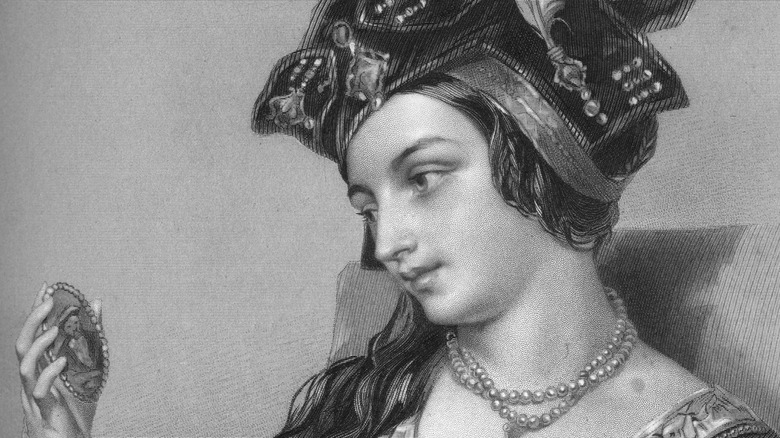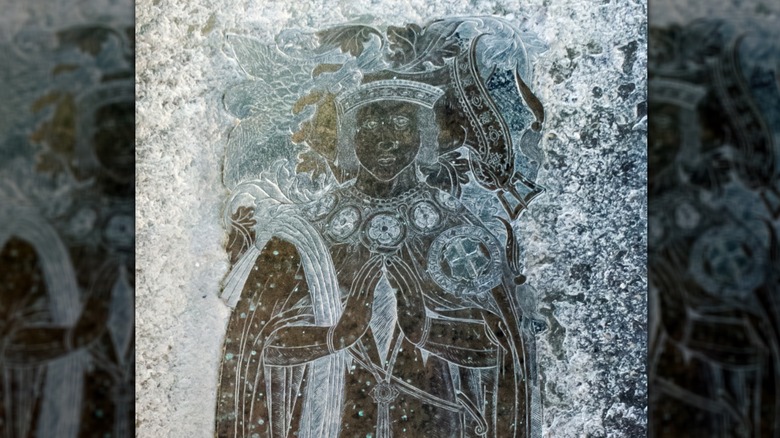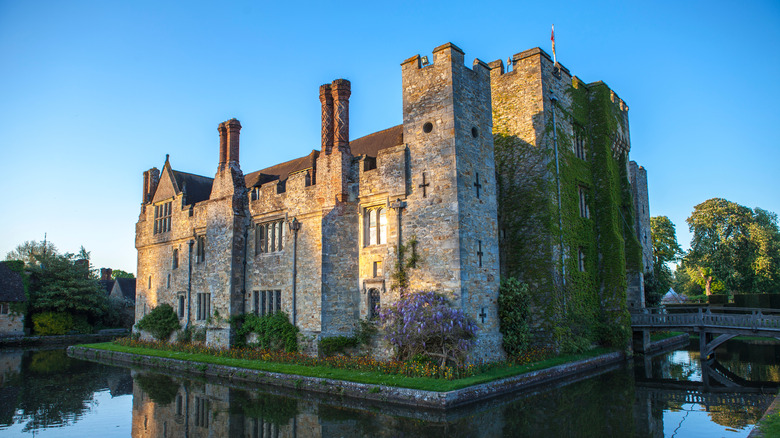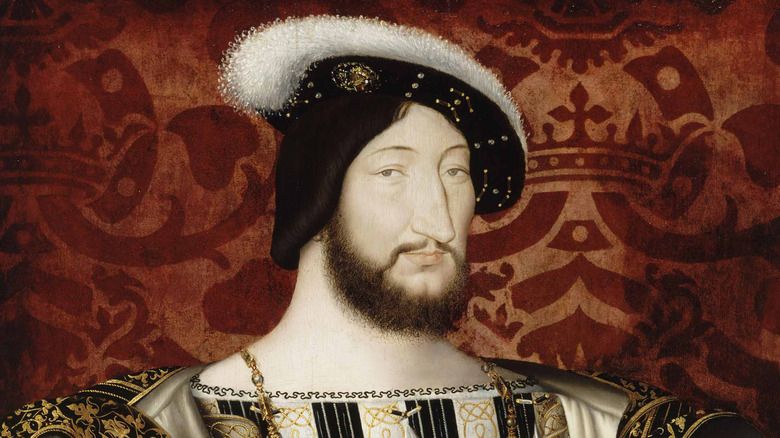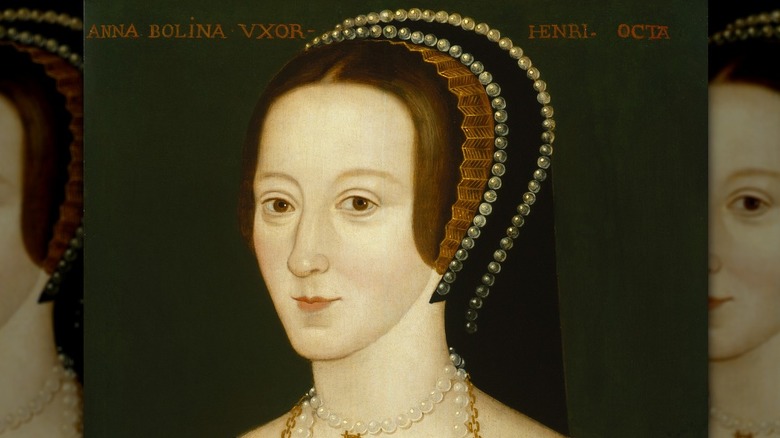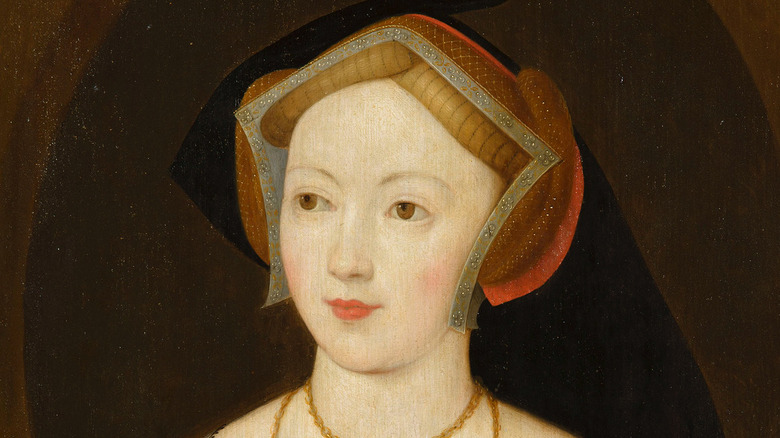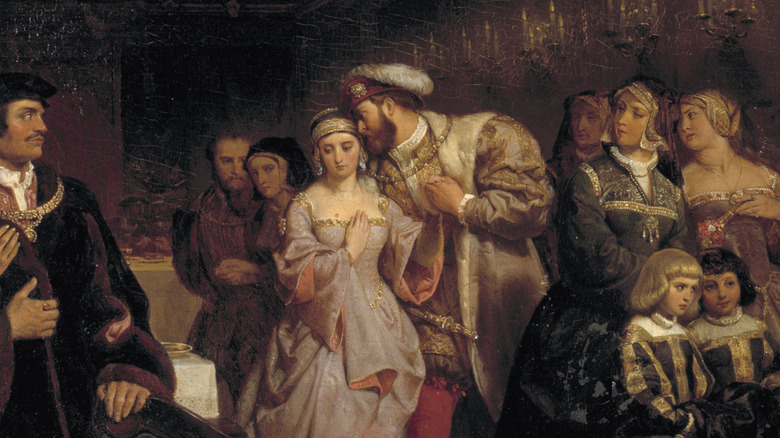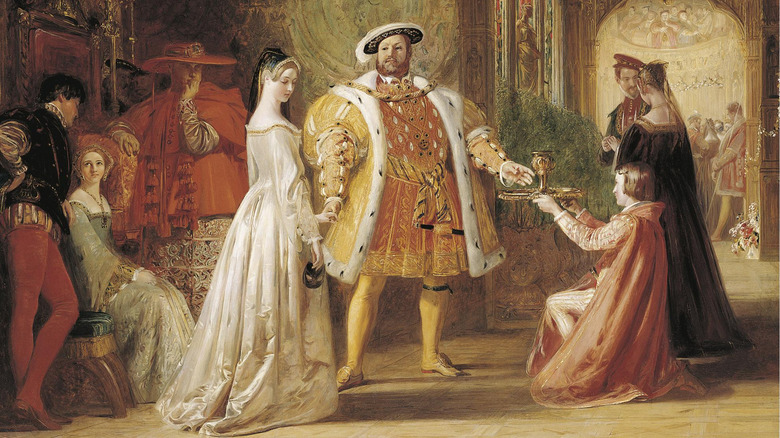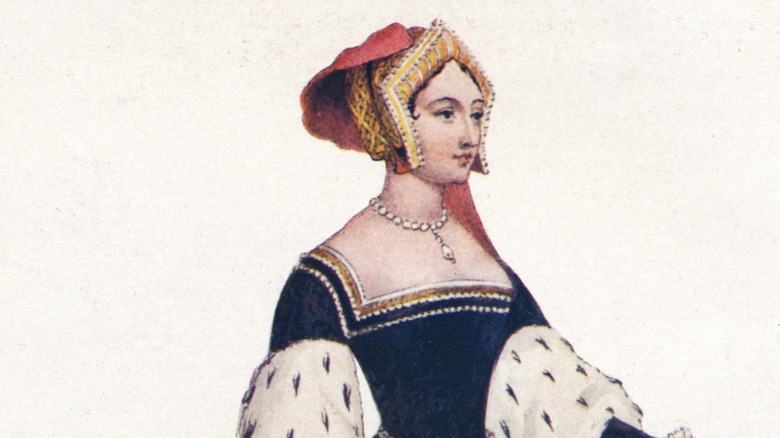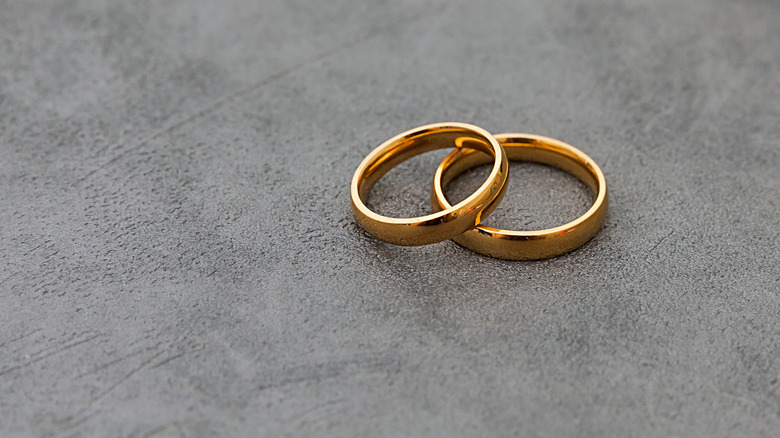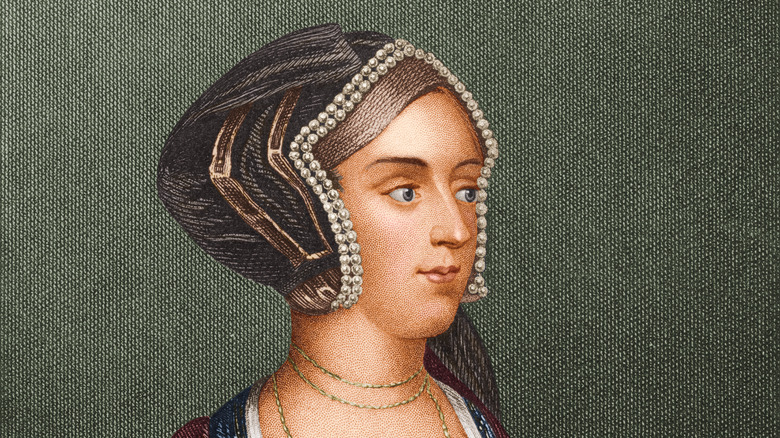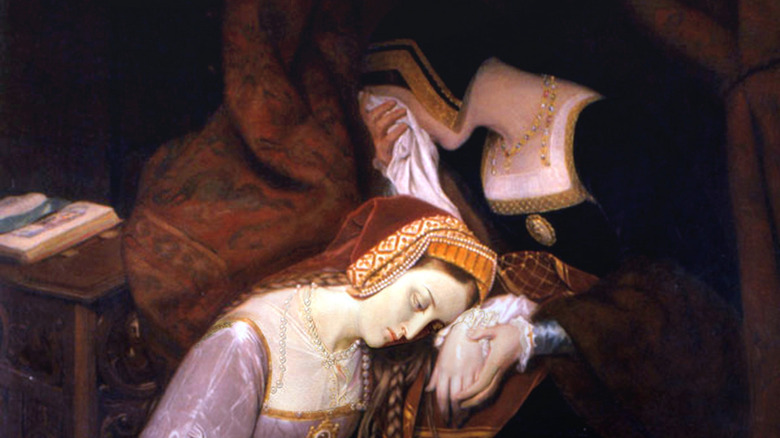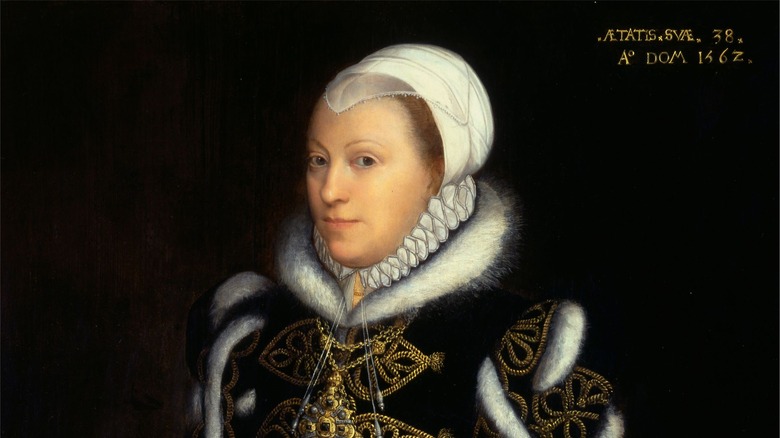Inside Mary And Anne Boleyn's Complicated Relationship
Many siblings out there have had their ups and downs. But what if you complicated that everyday sort of relationship with the presence of a monarch who was willing to upend a nation to get what he wanted? That would be Henry VIII, the English king who ruled from 1509 to 1547, and who complicated quite a few relationships in his quest to find the right wife, and produce a male heir.
Few others could more rightfully lay into Henry for what he did to their family than the Boleyn sisters. Anne Boleyn, whose 1533 marriage to Henry was part of the impetus not only for his divorce from first wife Katherine of Aragon, but the country's official turn to Protestantism, has become infamous. Whether you've got a sensational or sensible take on her, you've likely heard of Anne Boleyn. Of course, being beheaded in 1536 on the order of your royal husband will do that.
But there was another sister: Mary Boleyn. Her story is often sidelined in favor of the flashier tale of Anne, but she occasionally makes an appearance in tales of the Tudor period, most often because she was briefly mistress of Henry VIII. Yet both sisters have a more involved story to tell, especially when it comes to the complicated relationship between the two.
Both sisters came from an ambitious family
Most sources indicate that the Boleyns made their way from France to England in the Middle Ages, with one subset of the family settling in 13th-century Norfolk. With generations of merchants and landowners contributing to the family coffers, father Thomas Boleyn was born into a cushy situation in 1477. Besides receiving a high-class education, he also got in good with Henry VII, who gave Thomas prominent positions at court and status that carried through to the reign of Henry VIII. Thomas eventually became an ambassador, serving in the court of Margaret of Austria, who had key connections through her father, Holy Roman Emperor Maximilian.
Under Thomas, the Boleyns grew ever greater in power, wealth, and education, a state of affairs that benefited not only his son, George, but his daughters Mary and Anne as well. Besides the obvious financial benefits of growing up as a Boleyn, Mary and Anne plied their high social status into key roles as ladies in waiting in France (as well as, for Anne, at the intellectual and lively Margaret of Austria's court).
We don't precisely know when the two were born or in what order, though Mary has traditionally been accepted as the elder sister, being born around 1499 or 1500. Sources typically put Anne's birth shortly after, around 1501.
[Featured image by Jules & Jenny via Wikimedia Commons | Cropped and scaled | CC BY 2.0]
Anne and Mary were unusually well-educated
Even if no one could be bothered to write down the exact birth dates or birthplaces of either Mary or Anne Boleyn, they still had a unique advantage: an education. They wouldn't attend university, but with their family wealth and connections, they would learn far more about the world than the average Tudor peasant girl.
Mary would have begun her learning at Hever Castle, her family's estate in Kent. There, she would have tackled basics like mathematics and reading, while also working on skills required for ambitious noblewomen, like learning to play a musical instrument, taking up needlework, and learning all about the complicated ins and outs of court etiquette. Anne would have learned the same.
Historians have since often painted a picture of a shrewdly intelligent, energetic Anne and compared her to a less-bright Mary. Their father, they claim, eventually shrugged his shoulders and assumed Mary was at least pretty and rich enough to find a decent husband. However, much of that is speculation, and there's little evidence that Mary was educationally neglected. In fact, she may have done better than her more famous sister when it came to some subjects, like French.
Both sisters were sent to the French royal court
By the time both Mary and Anne were teenagers, it was time for the next phase of their education. But instead of calling in a new tutor, the Boleyn family sent them abroad. Anne appears to have gone first, setting out for Margaret of Austria's court in the Netherlands in May 1513. The next year, Mary gained a spot in the entourage of Mary Tudor, Henry VIII's younger sister, who was on her way to marry France's Louis XII. The French king died less than a year into the marriage, so the royal Mary soon traveled back to England to marry the Duke of Suffolk. However, Mary Boleyn stuck around at the court of the new king, Francis I.
Not even two years after joining Margaret of Austria's court, Anne traveled to France. Both sisters were there at the time of Louis XII's death in 1515 and stayed on to attend the new queen, Claude. Mary returned to England in 1519 and wed William Carey. Anne lingered a while longer, staying at Francis' court until about 1521 before returning home and joining the retinue of Katherine of Aragon, Henry VIII's first wife. At this point, Anne was reportedly set to marry Lord Henry Percy, but the secret engagement between the two meant they hadn't sought out royal permission, which angered Henry. He put an end to the match via Cardinal Thomas Wolsey.
Both dealt with salacious rumors
Both Boleyn sisters would deal with nasty rumors about their reputations. For Mary, the trouble seems to have started during her time at the French court. As rumor had it, she had been a mistress of Francis I, who was a rumored lothario with little interest in staying faithful to his wife. However, there's little clear evidence that the two made such a personal connection, apart from Tudor-period gossip hounds who may have had an interest in sullying the Boleyn name. Meanwhile, Francis left a trail of evidence behind for many of his other hookups. Nonetheless, historian Alison Weir told NPR that it's still possible that an affair briefly happened.
Anne's reputation proved to be even more spotted, with claims that she schemed her way into the English king's affections — though there's good evidence that she did no such thing. Henry had been quietly asking how a king might kick his wife to the curb well before Anne Boleyn joined his court and, when he did set his sights on Anne, she appears to have left his court in the summer of 1526 in an attempt to stave off the king's affections.
Little good that did her, as Henry would marry her — then accuse her of adultery, treason, and incest as an excuse for her May 1536 arrest and execution. Even after her death, rumors that she was a witch with an extra finger who gave birth to monstrous children plagued her name.
Mary was the first to wed
Not long after returning from France in 1519, Mary Boleyn married courtier William Carey in February 1520 and became an attendant to Katherine of Aragon. It was here that Henry VIII almost certainly set his eyes on her, as he had an established reputation for pursuing women in his orbit. After all, he openly acknowledged a son he had fathered with courtier Bessie Blount, a boy born in 1519 who went by Henry Fitzroy. Because of young Henry's illegitimacy, however, he was out of the line of succession, and his royal father was still anxiously trying to produce a legitimate male heir.
Mary and William, meanwhile, enjoyed a good position at court, palling around with the royals in a way that implied they were members of the king's inner social circle. William was clearly a key figure at court who earned Henry's respect. He was given fine horses out of a group meant for the king, as well as cushy appointments, promotions in rank, and rooms close to the king's, even after the affair between his wife and Henry was almost certainly over.
Mary became Henry VIII's mistress before Anne
Though it isn't clear when Mary Boleyn became the mistress of Henry VIII, the evidence for such a relationship is difficult to ignore. This includes a drafted dispensation sent to the pope, which would have cleared Henry to marry someone to whom he might technically be related ... like, oh, the sister of a previous mistress. Mary Boleyn and Henry VIII appear to have connected in the early 1520s after Mary wed William Carey — a ceremony attended by Henry. Around the same time, the king gave rather generous gifts to the new couple and Thomas Boleyn, perhaps an indication of growing closeness amongst their households.
In 1524, Mary gave birth to her daughter Catherine, followed by son Henry in 1526. Some have since speculated that the children's father was Henry. However, Henry never acknowledged them as his children and, as historian Alison Weir told NPR, she uncovered documents outlining Henry Carey's inheritance, which would have been complicated if anyone reasonably believed that he was the king's son. Most historians now believe that, by Henry Carey's 1526 birth, Mary's time as royal mistress was over.
At this point, Anne had already been part of the court for years and was recognized for her charisma and intelligence. By 1526, Henry was sending besotted love letters to Anne and ramping up his inquiries about how he might leave Katherine of Aragon, who had never managed to produce a living male heir for the king.
Anne may have learned from Mary's example
While the prevailing narrative has been that Anne Boleyn was holding out for Henry to make her queen, she may have been hoping to marry someone else, which could have been difficult if the king was constantly sniffing around.
It's also possible that Anne knew all about the affair between Mary and Henry and didn't like what she saw. We can't be sure how it all played out on a personal level, but perhaps Anne felt that Mary had been discarded once the king grew bored, and didn't want to be treated in such a careless way herself. That's speculation, of course, but there is decent evidence that she refused to do much of anything with the king until he assured her that she would be his only mistress. However, it's unlikely Anne expected him to break key religious and diplomatic relationships to annul his marriage to Katherine (whose nephew was the powerful Holy Roman Emperor Charles V) and marry her.
Despite her initial reluctance, Henry wore Anne down. The dispensation sent to the pope, drafted by 1527, would not only have cleared the king to marry a relative of a former mistress but would have also given him the go-ahead to marry a woman with whom he'd already shared premarital relations. This hints that they may have already begun a physical relationship.
Mary went quiet while Anne ascended
On June 22, 1528, William Carey died of the sweating sickness, an all-too-familiar disease that occasionally swept through England and the rest of Europe between 1485 and 1551. Anne Boleyn also contracted the illness in 1528, though she survived to the relief of a rather disease-phobic Henry VIII, who sent one of his own doctors to treat her. Mary Boleyn was left a widow with two young children.
At this point, the trail of Mary Boleyn grows hard to follow. She appears to have gone back to the family seat at Hever Castle, supported in part by a royal pension, but away from court. As a former mistress of the king, Mary may have been a destabilizing figure for Anne, who was in an awkward and unsteady position as a favorite of the king, but neither queen nor mistress.
Despite attempts to keep things quiet, rumors of royal mistress Mary Boleyn began to leak out. Yet Henry was clearly too into Anne to bother, even when Pope Clement VII told the king that he couldn't remarry, at least not if he didn't want to be excommunicated. By 1531, already defying the pope, Henry VIII had removed Katherine of Aragon from court. In January 1533, he married Anne, though technically the annulment of his first marriage didn't become official until May 1533. By 1534, it didn't matter, as Henry had been excommunicated and then deemed himself supreme head of the Church of England.
Anne kicked Mary out of court
Shocking as Anne's marriage to Henry VIII was, Mary soon had her own surprising news. In 1534, she got married again, but not to any old duke. Instead, she chose love in the form of a common soldier named William Stafford. What's more, she kept it hush-hush, apparently only revealing it when she showed up to court pregnant. About Stafford, she later boldly wrote to statesman Thomas Cromwell: "... that I had rather beg my bread with him than to be the greatest queen in Christendom" (though she was asking for Cromwell's help in the very same letter).
A presumably shocked Anne banished her newly-married sister from court. A Boleyn marriage to a nobody threatened to call the whole family's reputation into question, and Anne's marriage (not to mention the religious rebellion it occasioned) had already put a target on the Boleyns.
It's not clear where the two newlyweds went, though they likely made for Calais, France, where Stafford was stationed. Some sources indicate that they had two children: Edward (who died as a young child) and Anne, who may have made it to adulthood, but whose fate hasn't been uncovered. Eventually, Mary and William made it back to England while accompanying Anne of Cleves, on her way to become Henry VIII's fourth wife in late 1539. At this point, not only had Anne Boleyn been executed, but Thomas Boleyn had died as well, leaving Mary heir to part of the family fortune.
Anne initially helped support Mary, but they probably never reconciled
Before the whole affair of Mary's surprise marriage to William Stafford, Anne had already established a pattern of helping out her sister. After Mary's first husband died, Anne, who was not yet queen, but was certainly on a path to becoming at least a royal mistress, took on her nephew Henry Carey as a ward and employed a well-regarded tutor for his education. After William Carey's death, she also helped to secure Mary's widow's pension to support her newly single sister. Father Thomas Boleyn, also incensed by Mary's second marriage, eventually softened towards his rebellious daughter (at a certain point, the only one he had left) and set aside money for her before his death in March 1539.
But Mary's second marriage was nevertheless a breaking point that appeared to forever damage the relationship between the Boleyn sisters. There's no evidence that the two communicated in any way after Mary was ordered to leave court. The lurid drama of Anne's downfall happened while Mary and William Stafford were likely in exile in France, forgotten but at least insulated from the bloody events at Henry's court.
Henry's affair with Mary may have helped to doom Anne
Though Mary Boleyn can hardly be held responsible for her sister's downfall, she may have nevertheless had a part in Henry's plot to get rid of Anne. A dispensation drafted for the pope around 1527 would have allowed Henry to marry someone who was legally considered a close relative — like the sister of a former mistress. Given the timing, this document was meant to let Henry marry Anne, even though his earlier relationship with Mary made them potentially related, at least in a legal sense. The pope wasn't on board, but no matter. Henry would eventually decide to break with the church to get his way.
However, this tricky bit of legal business would come back into play when Henry and Anne's marriage began to falter, mere years after the wedding. With one living daughter and a miscarried son by January 1536, Henry had almost certainly begun to wonder if Anne would ever give him a legitimate male heir.
While the reasons Henry gave for her arrest and execution in May 1536 centered on trumped-up charges of adultery and treason, he may have also tried to play the legally related card in his favor. As Holy Roman Emperor Charles V's ambassador, Eustace Chapuys, wrote in a letter dated May 19, 1536: "Others tell me that the said Archbishop had pronounced the marriage of the King and Concubine invalid on account of the King having had connection with her sister."
Mary's lineage went much farther than Anne's
After her sister and father's deaths, Mary became the inheritor of about half of her family's money. However, the wealth was so legally tangled up it took years for her to access it. Four days after Mary finally came into possession of her inheritance, she died of unknown causes on July 19, 1543.
While Mary passed out of this world in relative obscurity, her family wasn't done making its mark on history. There was Anne Boleyn's daughter and Mary's niece, of course, the future Elizabeth I, who ruled England for 45 years. Mary's son Henry did well, too, securing a number of high titles and appointments under cousin Elizabeth, including becoming a knight of the Order of the Garter and the queen's Lord Chamberlain.
Mary's daughter Catherine Carey served as a maid of honor to Anne of Cleves and Catherine Parr, Henry VIII's fourth and sixth wives. She was later appointed as the high-ranking Lady of the Bedchamber by Elizabeth I. Catherine married courtier and politician Francis Knollys and had 16 children. These included Lettice Knollys, who got on Elizabeth's wrong side by marrying the queen's favorite, Robert Dudley. But where Elizabeth never produced an heir, Lettice's lineage lives on in the modern royal family via Princess Diana Spencer, a direct descendant. Queen Elizabeth II was also a direct descendant of Mary Boleyn via her mother, Elizabeth Bowes-Lyon, making the current heirs of King Charles III doubly descended from Mary Boleyn.
